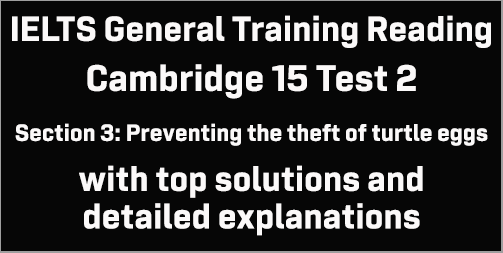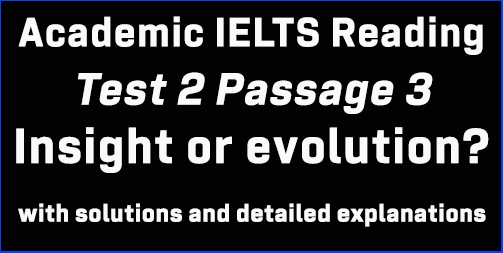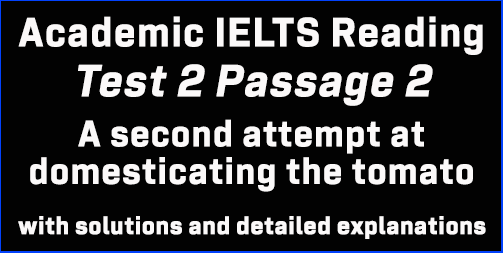IELTS General Training Reading: Cambridge 15 Test 2 Section 3; Preventing the theft of turtle eggs; with top solutions and best explanations
This General Training IELTS Reading post focuses on solutions to IELTS Cambridge 15 Reading Test 2 Section 3 that has a passage titled ‘Preventing the theft of turtle eggs’. This is a targeted post for GT IELTS candidates who have big problems finding out and understanding Reading Answers in the GT module. This post can guide you the best to understand every Reading answer without much trouble. Finding out IELTS Reading answers is a steady process, and this post will assist you in this respect.
IELTS Cambridge 15 Test 2: GT Reading Module
Section 3:
The headline of the passage: Preventing the theft of turtle eggs
Questions 28-33: List of headings
[In this question type, IELTS candidates are provided with a list of headings, usually identified with lower-case Roman numerals (i, ii, iii, etc,). A heading will refer to the main idea of the paragraph or section of the text. Candidates must find out the equivalent heading to the correct paragraphs or sections, which are marked with alphabets A, B, C, and so forth. Candidates need to write the appropriate Roman numerals in the boxes on their answer sheets. There will always be two or three more headings than there are paragraphs or sections. So, some of the headings will not be used. It is also likely that some paragraphs or sections may not be included in the task. Generally, the first paragraph is an example paragraph that will be done for the candidates for their understanding of the task.
Tips to answer this question: Don’t read the list of headings first. Have a quick look at the questions, and go straight to the first question and start reading the paragraph associated with it. Skimming is the best reading technique. You need not understand every word here. Just try to gather the gist of the sentences. That’s all. Read quickly, and don’t stop until you finish each sentence.]
Question 28: Section A
Look at lines 2-6 of section A, where the writer talks about the problems sea turtles are facing and the risk of present population of the sea turtles, “ . .. as human populations exploded and as sea turtles began to confront additional threats such as intensive fishing, beach development and climate change, sea turtle populations declined precipitously. Today, all but one of the world’s seven species of sea turtles are considered threatened according to IUCN* Red List. . . .”
Here, human populations exploded and as sea turtles began to confront additional threats such as intensive fishing, beach development and climate change = problems . . .. at a global level,
So, the answer is: iv (Problems facing sea turtles at a global level)
Question 29: Section B
Section B contains two paragraphs. Skim the first paragraph, “One major problem is that every year millions of sea turtle eggs are illegally taken by poachers for sale on the black market. The situation is particularly serious in Nicaragua, in Central America, which is home to four sea turtle species.”
Here, millions of sea turtle eggs are illegally taken by poachers = Intensive and large-scale poaching,
Nicaragua, in Central America = one location,
So, the answer is: vi (Intensive and large-scale poaching in one location)
Question 30: Section C
Section C contains two paragraphs. The second paragraph says, “But to protect the country’s sea turtles, Williams-Guillen said conservationists shouldn’t just depend on catching low-level operators. ‘If one poacher decides to stop, another one will just step into his place … we need to know more about the middlemen and people higher up in the distribution chain,’ she said.”
Here, If one poacher decides to stop, another one will just step into his place means catching the poachers may not solve the problem.
So, the answer is: vii (Why catching the poachers may not solve the problem)
Question 31: Section D
Section D discusses the creation of ‘fake turtle eggs’ which looks like the real eggs. The writer says in the first paragraph of section D, “Paso Pacifico’s solution is the creation of high-tech sea turtle eggs: fake eggs convincingly crafted to look like the real thing, .. . . .”
Here, look like the real thing = appears true to life,
Then, in the next three paragraphs of the same section, the writer provides details about the development of the item.
So, the answer is: i (Developing an item that appears true to life)
Question 32: Section E
Section E contains two paragraphs. The first paragraph discusses how to place fake eggs in turtle nests with real eggs. “Sea turtles on average lay around 100 eggs in a nest, and once the fake eggs are finished they will be slipped in with the real ones. . . .”
Then, in the second paragraph, the writer explains how to track illegal people (poachers) who steal turtle eggs using the fake eggs. “Once the poacher picks up the fake egg along with the real ones, conservationists and law enforcement agents will be able to track them.. . .. eventually make their way out of Nicaragua, possibly to El Salvador or Guatemala. . .. ”
Here, Once the poacher picks up the fake egg = collection of eggs, possibly to El Salvador or Guatemala = possible onward routes,
So, the answer is: v (Collection of eggs and their possible onward routes)
Question 33: Section F
In section F, take a close look at lines 3-4 of the second paragraph, “ . . .. So, Paso Pacifico plans to do a massive deployment of as many fakes as possible to gather a lot of data before poachers get wise.”
Here, plans to do a massive deployment of as many fakes as possible to gather a lot of data = short but intensive investigation,
Then, in the final paragraph, take a look at the last lines, “ .. .. And eventually Paso Pacifico hopes to share the technology with interested parties around the world.”
Here, hopes to share the technology with interested parties around the world = longer-term follow-up.
So, the answer is: iii (A short but intensive investigation with longer-term follow-up)
Questions 34-37: Multiple choice questions
[This type of question asks you to choose a suitable answer from the options using the knowledge you gained from the passage. Generally, this question is set found as the last question set in most passages so you should not worry much about it. Finding all the answers to previous questions gives you a good idea about these questions.]
Question 34: What does the writer suggest about the flatback turtle?
Keywords for this question: flatback turtle,
The answer is in section A in the last half where the author says, “ .. . .. Today, all but one of the world’s seven species of sea turtles are considered threatened according to the IUCN* Red List. And the one that’s not – the flatback turtle – is listed as data deficient, which means scientists simply don’t know how it’s doing.”
Here, scientists simply don’t know how it’s doing = It could be as severely threatened as other turtles,
So, the answer is: A (It could be as severely threatened as other turtles.)
Question 35: Williams-Guillen says that the poaching of sea turtle eggs in Nicaragua –
Keywords for this question: Williams-Guillen, poaching of sea turtle eggs, Nicaragua,
Take a look at lines 2-4 of paragraph no. 1 in section C, “. … .. Williams-Guillen said. ‘Although many poachers are locals with limited resources, during these arribadas there are influxes of gangs of poachers from larger cities outside local communities. These are not just local poor people without other options.”
Here, there are influxes of gangs of poachers from larger cities outside local communities = highly organised structure,
So, the answer is: C (sometimes has a highly organised structure.)
Question 36: In section E, Williams-Guillen says that one way to encourage poachers to take the fake eggs is to –
Keywords for this question: section E, Williams-Guillen, one way, encourage poachers, take the fake eggs,
The answer can be found in section E, in the first paragraph. Take a look at lines 2-6, “. . .. Williams-Guillen said it might even be possible to deliver fake eggs into nests while poachers are at work. Wary of tourists, poachers will often back off if strangers come near and then return when they have gone. ‘It would be pretty easy to drop an egg in the dark into a nest they have been digging up,’ she said.”
Here, it might even be possible to deliver fake eggs into nests while poachers are at work = put them in nests that the poachers have started to dig up,
So, the answer is: D (put them in nests that the poachers have started to dig up.)
Question 37: It is planned to use a large number of fake eggs at the beginning because –
Keywords for this question: planned to use, large number of fake eggs, beginning, because,
Take a look at section F, paragraph no. 2, lines 3-4, “. . . . So, Paso Pacifico plans to do a massive deployment of as many fakes as possible to gather a lot of data before poachers get wise.”
Here, poachers get wise indicates that when poachers become aware of the fake eggs, the project may fail (may not be possible to continue the project indefinitely). So, a large number of eggs are planned to be used (a massive deployment of as many fakes as possible) before the poachers get wise.
So, the answer is: B (It may not be possible to continue the project indefinitely.)
Questions 38 – 40: Summary completion
[In this kind of question candidates are given a summary for one, two, or three paragraphs with some fill in the blanks questions. Candidates need to find out the related paragraphs by correctly studying the keywords from the questions. Then, they should follow the steps of finding answers to fill in the gaps.]
Title of the summary: Making convincing sea turtle eggs
All the answers can be found in section D.
Question 38: One difficulty in creating a fake sea turtle egg is to get the appropriate texture for the Shell. Unlike a bird’s egg, a turtle’s egg has a shell which is _________ .
Keywords for this question: one difficulty, creating, fake sea turtle egg, get, appropriate texture, Shell, unlike, bird’s egg, turtle’s egg, has, shell, which,
In section D, the writer says in the second paragraph, “ . .. .. In particular, it’s proving quite problematic to create the right texture, since sea turtle eggs are not covered in hard shell like those of birds, but are quite flexible.”
Here, right texture = appropriate texture, are not covered in hard shell like those of birds = unlike a bird’s egg,
So, the answer is: flexible
Question 39: Lauren Wilde has studied eggs from Californian turtles that live on _________ to create a realistic reproduction of the shell.
Keywords for this question: Lauren Wilde, studied, eggs, Californian turtles, live on, create, realistic reproduction, shell,
In Section D, the writer states in the third paragraph, “So Paso Pacifico brought in Lauren Wilde, a special effects artist in the US, to create a convincing outer shell. First, Wilde had to get her hands on the real thing. Since it’s illegal to send sea turtle eggs over the border, Wilde is using land turtle eggs from California. . . . .”
Here, Wilde is using = Lauren Wilde has studied eggs, to create a convincing outer shell = to create a realistic reproduction of the shell,
So, the answer is: land
Question 40: A GPS device will then be placed inside a ________ in the fake shell. Finally, silicone will be applied to the shell to make it waterproof.
Keywords for this question: GPS device, will, be placed, inside, in, fake shell,
The final paragraph of section D mentions, “To get the GPS device inside the shell, Paso Pacifico is using 3D printers to make a plastic ball which will then have a GPS transmitter fitted inside. This will take the place of the embryo inside the shell. Lastly, the fake shells will be sealed with silicone, waterproofing them.”
Here, inside the shell = in the fake shell,
So, the answer is: ball
Click here for solutions to Cambridge 15 GT Test 2 Section 1
Click here for solutions to Cambridge 15 GT Test 2 Section 2




There is no paragraph G in section 3 of this test so explanation given for answer # 34 does not seems to be correct. Can you please help with correct logic of this answer?
I’ve fixed the problem. Take a look and please let me know if that’s ok.
Thank you.